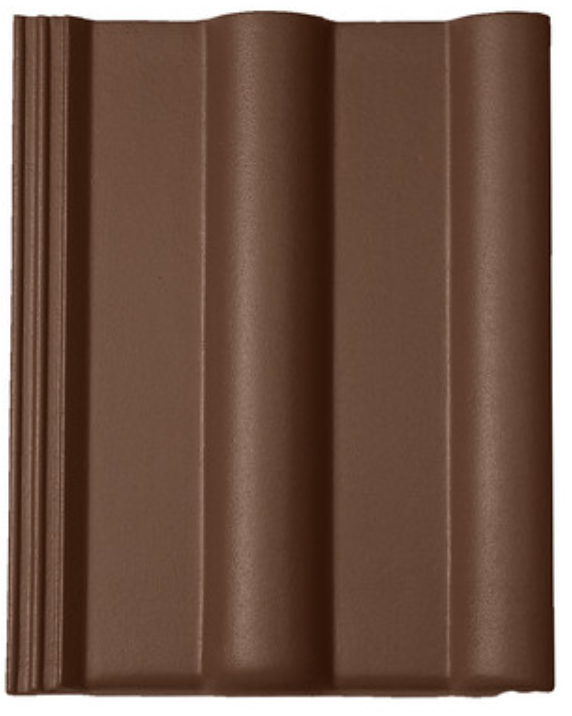Dachówki cementowe. Jak powstają. Cement roofing tiles. How they are created.

Z wielu moich artykułów o wykonanych pracach mogliście się już dowiedzieć, że jednym z najbardziej popularnych materiałów (dachówek) używanych do pokrycia są dachówki cementowe (betonowe). Oczywiście główny wpływ na popularność ma cena tych dachówek. Ale nie tylko. Również technologia produkcji dachówki cementowej wciąż jest udoskonalana, a to przekłada się bezpośrednio na jej jakość, trwałość oraz producencki okres gwarancyjny. Taka gama walorów kusi już potencjalnego klienta.
From many of my articles you have already learned that one of the most popular materials (tiles) used for covering are cement (concrete) tiles. Of course, the price of these tiles has a major impact on popularity. But not only that. The technology of cement tile production is also constantly being improved, which directly translates into its quality, durability and producer warranty period. Such a range of advantages already tempts potential customers.
Jak sama nazwa wskazuje dachówki cementowe wykonuje się ze specjalnej mieszanki betonowej. Nie jest to typowa mieszanka betonowa. W jej skład wchodzą :
- drobnoziarnisty (poniżej 4 mm) piasek – ok. 70%;
- cement portlandzki bez dodatków o wysokiej wytrzymałości wczesnej – ok. 18% ;
- woda – ok. 7,5%;
- mączka skalna hydrauliczna – ok. 3%.
- pozostała zawartość procentowa masy to barwniki w postaci tlenków metali.
As the name suggests, cement tiles are made of a special concrete mix. It is not a typical concrete mix. It is composed of :
- fine sand (less than 4 mm) - approx. 70%;
- Portland cement without additives of high early strength - approx. 18% ;
- water - approx. 7.5%;
- Hydraulic rock meal - approx. 3%.
- the remaining percentage by weight are dyes in the form of metal oxides.
Mieszanka do produkcji dachówek jest dokładnie zagęszczana. Czynność ta jest dosyć ważna, dlatego też jest wykonywana w taki sposób aby było w niej jak najmniej pęcherzyków powietrza.Im więcej bąbli w mieszance tym bardziej wpływają na porowatość dachówek.
Podstawowe składniki trafiają do maszyny mieszającej. Z mieszarki dobrze uformowana mieszanka trafia do tzw prasy ciągnionej. Na niej jest nakładana na wyprofilowane podkładki, a potem poddana walcowaniu oraz wygładzaniu (wygładzana jest powierzchnia zewnętrzna).
Powstaje w ten sposób długie profilowane pasmo, które dalej jest cięte na odpowiednią długość dachówki.
Gdy elementy (dachówki) są jeszcze wilgotne, ich powierzchnię ulepsza się poprzez powleczenie wodorozcieńczalną farbą akrylową. Ów farba wiąże się ze świeżym betonem oraz gruntuje podłoże. W następnym kroku dachówki "dojrzewają" w specjalnych suszarniach, przez okres przez 8–12 godzin. W suszarniach panuje stała temperatura (do 60°C) a także wilgotności. Na tym etapie dachówki uzyskują wytrzymałość początkową równą bądź bliską. 70% wytrzymałości końcowej produktu.
Cały ten proces jest znacznie mniej energochłonny w porównaniu z wypalaniem dachówek ceramicznych. Właśnie to wpływa głównie na obniżoną cenę pokryć cementowych, nawet o 15 do 30%.
Gdy dachówka osiągnie już "wytrzymałość wstępną" oraz opuści suszarnię, wszystkie dachówki są po raz kolejny powlekane farbą akrylową.
Aby dachówka cementowa mogła być dopuszczona do sprzedaży w hurtowniach
musi być jeszcze sezonowana przez około 30 dni, to czas gdy osiąga pełną wytrzymałość.
The tile compound is accurately compacted. This operation is quite important, therefore it is carried out in such a way that there are as few air bubbles as possible.
The more bubbles there are in the mix, the more they influence the porosity of the tiles.
The basic ingredients are transferred to the mixing machine. From the mixer the well-shaped mixture is transferred to the so-called towed press. It is applied to the profiled washers and then rolled and smoothed (the outer surface is smoothed).
This results in a long profiled strand, which is then cut to the required length.
When the tiles are still damp, the surface is improved by coating them with water-thinnable acrylic paint. This paint binds to fresh concrete and primes the substrate. In the next step, the tiles are "matured" in special drying rooms for a period of 8-12 hours. Drying rooms have a constant temperature (up to 60°C) as well as humidity. At this stage, the tiles achieve initial strength equal to or close to the tiles. 70% endurance of final product.
The whole process is much less energy intensive than firing ceramic tiles. This is the main reason for the reduced price of cement coatings, by as much as 15 to 30%.
Once the tile has reached its "preliminary strength" and has left the dryer, all tiles are coated with acrylic paint once again.
In order for a cement roofing tile to be allowed to be sold in warehouses
must still be seasoned for about 30 days, the time when it reaches full strength.

Producenci uzyskują kolor dachówki przez barwienie w masie a także przez powierzchniowe, dwu- lub trzykrotne pokrywanie dachówki barwioną powłoką akrylową na bazie wody. Używane do tego farby to: farba akrylowa, akrylowo-polimerowa lub akrylowo-silikatowa.
Powłoka akrylowa oprócz ciekawego koloru i połysku zabezpiecza dachówkę przed wchłanianiem wody oraz wilgoci z powietrza. Niemniej jednak powłokę taka trzeba odnawiać gdyż z czasem ulega degradacji (pisałem o tym m.in. TUTAJ.
Manufacturers obtain the colour of the tile by dyeing the tile by weight, as well as by covering the tile with a water-based acrylic tile surface two or three times. The paints used are acrylic, acrylic-polymer or acrylic-silic.
Apart from interesting colour and gloss, the acrylic coating protects the tile against absorption of water and moisture from the air. However, such a coating needs to be renovated because it is subject to degradation over time (I wrote about it, among others, HERE.
Do czynności barwienia dachówek cementowych producenci stosują tylko barwniki pochodzenia nieorganicznego. Dzięki temu nie ma obaw , że produkty stracą intensywność koloru pod wpływem promieni UV, innymi słowy kolor nie zblaknie, nie spłowieje. Cześć producentów dodaje pigmenty również na początku, do masy cementowej. Dzięki temu uzyskuje się wyroby barwione w masie, co wpływa na estetykę dachówki ciętej, szczególe w koszach czy przy oknach połaciowych. Najczęściej są to tlenki żelaza, dające barwę czarną, brązową, czerwoną oraz ich odcienie. Bez stosowania pigmentów, uzyskuje się dachówki w kolorze naturalnym, szarym.
For the dyeing of cement roofing tiles, manufacturers only use inorganic dyestuffs. This means that there is no risk that the products will lose their colour intensity when exposed to UV light, in other words the colour will not fade. Some manufacturers also add pigments to the cement mass at the beginning. This results in products dyed in the mass, which affects the aesthetics of the cut tiles, details in the baskets or at the slope windows. Most often they are iron oxides, which give black, brown, red colour and their shades. Without the use of pigments, natural grey tiles are obtained.

tegalit protegon
Nowoczesne technologie produkcji:
Modern production technologies:
Protegon – podczas produkcji dodawane są pigmenty, które odbijają promieniowanie podczerwone, dzięki czemu temperatura pod spodem dachówek jest niższa nawet o 10°C. To znacznie zmniejsza nagrzewanie całego dachu.
During production, pigments are added that reflect infrared radiation, which reduces the temperature underneath the tiles by up to 10°C. This significantly reduces the heating up of the entire roof.
Protector – w tej technologii stosuje się bezbarwną i gładką powłokę antyzabrudzeniową. Zwiększa ona odporność na negatywny wpływ wszelakich czynników atmosferycznych. W tej technologii produkty na długo zachowują swój intensywny kolor.
This technology uses a colourless and smooth anti-dirt coating. It increases the resistance to the negative influence of all atmospheric factors. With this technology, the products retain their intense colour for a long time.
Cisar – podczas produkcji w tej technologii dachówki produkowane są z warstw:
- nośnej - barwionej w masie
- wygładzającej - nsyconej danym kolorem trwałej masy drobnoziarnistej
- uszlachetniającej - dwukrotnie nakładana powłoka polimerowo-akrylowa.
During the production process, the tiles are made of layers: - load-bearing - coloured in the mass
- smoothing - saturated with a given colour permanent fine-grained mass
For the finishing industry, a polymer-acrylic coating is applied twice.
Lumino - nadaje dachówkom odpowiednio większy połysk, zdecydowanie intensywniejszy i trwały kolor. Zwiększa również odporność na zabrudzenia.
-gives the tiles a correspondingly higher gloss, much more intense and durable colour. It also increases the resistance to dirt.
Duratop – gładka, nadająca dachówce połysk, powłoka zwiększająca odporność na promieniowanie UV oraz wnikanie i osiadanie zanieczyszczeń. Dach na długo zachowuje intensywny kolor i czystość powłoki, bez konieczności dodatkowych zabiegów pielęgnacyjnych.
- Smooth, glossy coating to increase UV resistance and the penetration and settling of contaminants. The roof retains its intense colour and purity for a long time, without any additional maintenance.

celtycka
Produkcja dachówek cementowych to systematycznie rozwijająca się gałąź przemysłu szeroko rozumianych pokryć dachowych. Dzięki coraz bardziej nowoczesnym technologiom produkcji ale również trwalszym materiałom, farbom, powłokom dachówki cementowe stają się coraz bardziej konkurencyjne wobec wyrobów ceramicznych. Niewątpliwie już i tak wysoka popularność tego materiału będzie jeszcze rosła. Czy dachówki cementowe mają szanse wyprzeć ceramikę z rynku? Czas pokaże.
The production of cement roofing tiles is a systematically developing branch of the roofing industry in the broad sense of the word. Thanks to increasingly modern production technologies, as well as more durable materials, paints and coatings, cement roof tiles are becoming more and more competitive than ceramic products. Undoubtedly, the already high popularity of this material will continue to grow. Are cement tiles likely to drive ceramics out of the market? Time will tell.

romańska
Vote! Resteem! Comment!